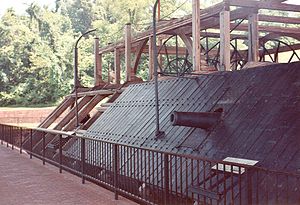Casemate ironclad



The casemate ironclad was a type of iron or iron-armored gunboat briefly used in the
Overview
In its general appearance, a casemate ironclad consisted of a low-cut hull with little
The casemate ironclad being steam driven, either by screws or by paddle-wheels, it did not need sails or masts, although sometimes, when not in combat, temporary pulley-masts, flagpoles, davits, and awnings were added. Inside the casemate, the guns were housed in one continuous deck. Unlike with turret ironclads, the guns had to fire through fixed gunports and therefore aiming was done by moving the gun relative to the gunport. This was labor-intensive and often up to 20 men were needed to load, aim, fire, and clean a gun, and even with this manpower the firing rate was no better than one shot per five minutes.[citation needed]
Although the
Furthermore, even the relatively modest aim of limited seaworthiness was rarely achieved, since the Confederacy had to make do with repurposed and underpowered machinery that was originally designed to power wooden vessels, and which was unsuited for powering the now-heavier casemate ironclads, seriously hampering their maneuverability and leading to many grounded Confederate ironclads being unable to free themselves without help.
Outside North America
In their specific outer appearances, i.e. being essentially floating gun batteries encased in armored citadels, albeit powered, the low-freeboard Union and Confederate casemate ironclads were almost uniquely North American. However, the concept of a fixed armored citadel mounted on a warship housing the main armament itself was further explored by European navies in the last third of the 19th century, by the French and British navies in particular, in no small part due to the inspiration gained from the Battle of Hampton Roads. This resulted in larger, high-freeboard ironclad frigates or battleships the British dubbed "centre battery ships" and the French "casemate" or "barbette" (if the citadel was circularly shaped) ships, which were oceangoing, unlike the American originals (excepting the Confederacy's CSS Stonewall, the only Confederate high-freeboard and oceangoing barbette/casemate ironclad, and the Union's rather unusual low-freeboard, but equally oceangoing, casemate ironclad USS Dunderberg). British examples were, among others, HMS Bellerophon (the first such one completed by the British in 1865) and HMS Hercules (1868). French examples included Brasil (casemate, and as the name implies, completed for the Brazilian Navy in 1865, and, when stripped of its masts, sharing a striking side-profile similarity with its Confederate progenitors) and Redoutable (barbette, and the first warship in history to be constructed in steel in 1878, instead of iron).[11][12]
Two earlier and rarer examples – having more in common with American ironclads – concerned the
References
- ^ Konstam, 2002 (1), p.15
- ^ Preston, 1979, p. 24
- ^ Konstam, 2001, pp. 5–9
- ^ Konstam (1), 2002, p.16
- ^ Scharf, 1894, p. 673
- ^ Konstam, 2002 (1), p. 14
- ^ Melton, 1968, pp. 27–28
- ^ Konstam, 2001, p. 3
- ^ Konstam, 2001, pp. 11–12
- ^ Melton, 1968, pp. 155–161
- ^ Preston, 1979, pp. 20–39
- ^ Hill, 2002, pp. 28–71
- ^ Preston, 1979, pp. 43–45
Bibliography
- Hill, Richard (2002). War at Sea in the Ironclad Age (paperback version of the 2000 first, hardback ed.). London, UK: Cassell. p. 240. ISBN 0304362670.
- Konstam, Angus (2001). Confederate Ironclad 1861-65. Osprey Publishing. p. 48. ISBN 9781841763071.
- Konstam (1), Angus (2002). Hampton Roads 1862: First Clash of the Ironclads. Osprey Publishing. p. 48. ISBN 9781841764108.]
{{cite book}}: CS1 maint: numeric names: authors list (link), Book[permanent dead link - Konstam (2), Angus (2002). Union River Ironclad 1861-65. Osprey Publishing. p. 48. ISBN 9781841764443.)
{{cite book}}: CS1 maint: numeric names: authors list (link - Melton, Maurice (1968). The Confederate Ironclads. South Brunswick, New Jersey: Thomas Yoseloff Ltd. p. 319. OCLC 559832629.
- ISBN 0896730115.
